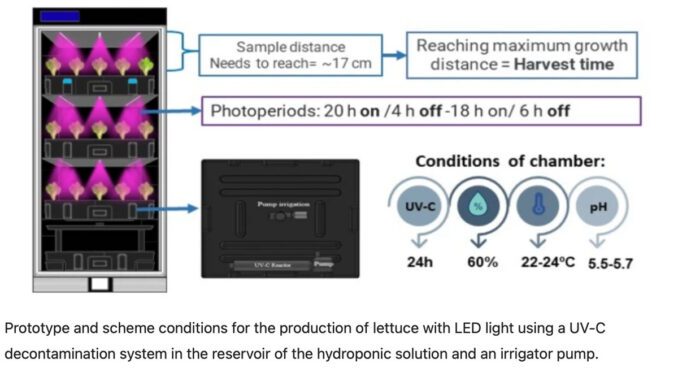
Enhanced vegetable production in hydroponic systems using decontamination of closed circulating fluid
- Shirly Lara Perez,
- Rafael Basilio Ferro,
- Bruna Corrêa,
- Rene Casarin,
- Thaila Quatrini Corrêa,
- Kate Cristina Blanco &
- Vanderlei Salvador Bagnato
Scientific Reports volume 14, Article number: 602 (2024)
Abstract
While plant microorganisms can promote plants by producing natural antibiotics, they can also be vectors for disease transmission. Contamination from plant management practices and the surrounding environment can adversely affect plants, leading to infections and hindered growth due to microbial competition for nutrients. The recirculation of nutrient-rich fluids can facilitate the transport of microorganisms between vegetables in the hydroponic production system. This issue can be addressed through the application of the decontamination method in the hydroponic liquid. Ultraviolet light (UV-C) has been employed for microbiology, and its effects on lettuce were evaluated in this study. This study aims to assess the effectiveness of a decontamination system using UV-C in hydroponic solutions during nutrient recirculation in hydroponics. We evaluated the time required for lettuce plants to reach their maximum height, as well as their pigment content, phenolic compounds, antioxidant capacity, and micro and macronutrient levels. The evaluation was conducted under two photoperiods (18 and 20 hours) in lettuce samples exposed to UV-C in the hydroponic fluid, with control groups not exposed to UV-C. The application of the UV-C decontamination system in hydroponic circulation water containing nutrients accelerated plant growth while maintaining nutritional values equal to or higher than those in the control groups without such a system. The results of microorganism control highlight the potential application of this technique for enhancing and expediting vegetable production. This approach reduces production time and enhances nutrient absorption and the content of certain compounds and minerals.
Results
The microbial quantification curve (Fig. 2) was constructed at 24 h intervals throughout 168 h, revealing consistent growth patterns and proliferation trends, whether UV-C light was applied concurrently with or independently from vegetable production. During the initial phase of the microbial growth curve (exponential phase), a significant reduction in slope was observed when UV-C light was employed. This reduction contrasted with the rapid bacterial proliferation observed in the absence of UV-C light (N-UV-C) during the initial two days of the curve. The microbial population reached its maximum levels (2.9 and 4.5 CFU/mL) when exposed and not exposed to UV-C light, respectively. This phenomenon can be ascribed to limiting factors affecting growth. However, in the stationary phase, observed in the curve without UV-C light, there was an interval between days 4 and 7, with some cells multiplying (7 days) while others perished at a similar (between days 4 and 6). Such dynamics were not observed in the UV-C light curve, where the rate of cell death exceeded that of proliferation. The UV-C-treated curve displayed a shortened microbial death phase by three days, signifying an irreversible loss of cell division capacity in an environment maintaining specific levels of salts, amount of water, and temperature favorable to microbial growth. The data imply that exposure to UV-C light harmed microorganism growth and survival, resulting in a decrease in the exponential phase, a restriction in maximum population size, and a shorter death phase, all of which are significant in microorganism control applications19.
READ FULL UV-C Decontamination Hydroponics STUDY WITH CHART & IMAGES HERE: https://www.nature.com/articles/s41598-023-50974-9
